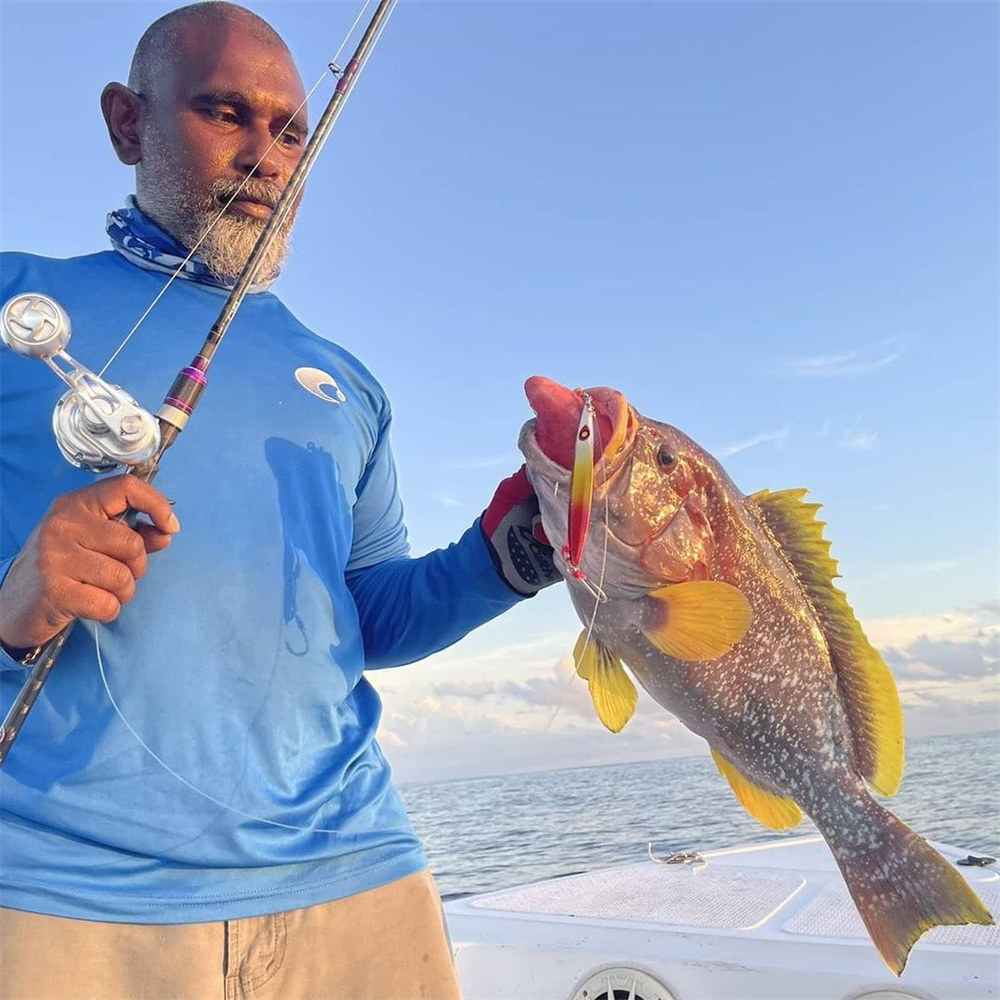Offshore fishing happens in the vast open waters miles from the shore, which makes finding the fish that much harder. When searching for the right place to wet a line, your eyes can only help so much, because most of the best spots can’t be seen from the surface. Whether you’re trying to branch out or explore a new area, here’s what you need to know to find the best offshore fishing spots.
You can find saltwater fishing locations based on the following factors
1.Bottom structure
2.Floating structure
3.Seafloor topography
4.Current factor
5.Bird factor
6.Offshore fishing sites
Submarine Structure
Submarine structures consist of reefs and pieces of shipwrecks that soon become artificial reefs. These structures are great for snapper, grouper, amberjack and other benthic fish because it supports abundant prey and provides plenty of hiding places. Coral reefs and wrecks are complete ecosystems. While demersal fish live in the reefs, large pelagic species, including dorado, kingfish and wahoo lurk in the surrounding areas.
Floating Structures
In open water, anything that provides cover attracts baitfish that are quickly spotted by predatory fish. Relatively small floating structures, such as buoys and debris, usually have a cloud of baitfish hiding in its shadow, making them a popular gathering place for cobia and other offshore game fish. Buoys are also used as markers for structure below the surface, which makes them a great place to see what you’re looking at.
At the other end of the spectrum from being illuminated by light, offshore oil platforms are huge floating structures that are common in the Gulf of Mexico. These rigs are loaded with baitfish and attract a variety of fish. Closer to shore, these platforms are home to reef fish and smaller pelagic species. In deeper waters, huge yellowfin tuna, kingfish and wahoo forage can be caught on tows or even sight casts.
Submarine Terrain
In addition to coral reefs, there are a variety of other types of terrain to look for on a map or depth finder. Any rapid change in the topography of the seafloor is a strong indicator that fish may be present. Specific terrain features to look for are ledges, humps, canyons and points that are easily identified.
Assuming you’ve fished offshore, chances are you’ve heard of the continental shelf and the 100 fathom curve. The continental shelf is a distinct drop-off where the bottom of the land ends. the 100 fathom curve marks the depth of water where some of the biggest fish are often found. Both are reliable spots that are targeted by anglers around the world.
Current Factors
By pushing food resources to different areas, currents play a large role in where and when fish feed. While some maps have currents, many do not because currents are highly variable. To see the most recent conditions, check the NOAA Tides and Currents map.
Currents push and pull different types of water, moving fish that are looking for different conditions or hunting for food. Favorable water conditions driven by the dominant currents will tell you where the fish want to go and the closest terrain or structure is where they are feeding.
In the United States, the most popular current for anglers is the Gulf Stream, which moves warm water from the Gulf to the East Coast. This warm current is usually located in deep valleys. Fish use it as a migration corridor and as a major hunting ground. The Gulf Stream is one of the best places to find fish year-round.
The Bird Factor
This technique of locating fish can be used in all water types, but is most effective in open, offshore waters. If baitfish are pushed to the surface by a school of predatory fish, birds will quickly join in for an easy meal. While finding surface disturbance from schools of fish impacting the water is also a good tactic, it can be difficult to do from a distance.
Birds will begin to hover and dive into schools of baitfish that can be seen from at least a mile away. If you spot birds circling or flying in a specific direction, following them will likely lead you to a strong nest of fish.
Offshore Fishing Spots
Finding the best offshore fishing spots can take years of hands-on experimental testing, but knowing what to look for will shorten the learning curve considerably. If you’re looking for a new spot, get out your map and look for underwater topographic features, reefs, wrecks, large structures and strong currents.
Once you’re in the water, check for floating objects and keep an eye on the sky, as birds can lead you to fish. Guides and charter captains have local experience gained from years of living on the water and are usually more than happy to share what they have learned.
Check out our fishing charters and get in on the action while learning how and where to fish.
Conclusion about Find Saltwater Fishing Spots
Bottom Structure: Look for areas with varied bottom structures like reefs, rocky areas, or drop-offs. These areas attract fish as they provide shelter and food sources.
Floating Structure: Pay attention to floating structures such as buoys, piers, and floating debris. These can act as gathering points for fish or attract smaller baitfish, which in turn draw larger predatory fish.
Bottom Topography: Study the underwater topography, including channels, ledges, and holes. These features create natural pathways for fish and can concentrate their activity.
Current Factors: Understand the influence of tides and currents on fish behavior. Fish often gather in areas where there are changes in water movement, such as tidal rips, eddies, or current breaks.
Bird Factor: Keep an eye on bird activity, particularly seabirds like seagulls or pelicans. They often indicate the presence of fish, as they feed on the same baitfish that larger fish target.
Offshore Fishing Sites: If you’re planning offshore fishing, research known offshore structures like wrecks, artificial reefs, or underwater features. These locations can hold a variety of game fish and are often marked on nautical charts or fishing guides.
By considering these factors and conducting thorough research, you can increase your chances of finding productive saltwater fishing locations. Additionally, consulting local anglers or fishing guides familiar with the area can provide valuable insights and further enhance your fishing experience.
FAQ about Find Saltwater Fishing Spots
①How do you know where fish are in the ocean?
Fish finding sonar systems assist fishermen and scientists when trying to locate and identify fish underwater. These sonar units operate very similar to other types of sonar. A transducer, attached or towed by a boat, sends out an acoustic signal.
②Do fish finders work in salt water?
Saltwater fish finders are one of the most vital marine electronics in your arsenal, especially if you’re an angler looking to land a trophy fish. With so many models on the market, it can be hard to know which is right for you, especially if you don’t deal with them daily.
③What time of day is best for saltwater fishing?
Specifically, dawn or dusk are generally the best time to go saltwater fishing if the weather and tidal movements are favorable. Remember to reference a saltwater tide chart to see which range of hours during the day will be the best fishing tide times.
④At what depth do most fish live in the ocean?
The area of the ocean between 650 and 3,300 feet (200-1,000 m) is called the mesopelagic. Barely any light filters down to these depths, and yet still life thrives here. Squid, krill, jellies, and fish are super abundant in this zone.
⑤What color is best for saltwater fishing lures?
In saltwater, red, orange, blue and black work best early in the day. When the sun is bright, switch to white, green and chartreuse. Red, orange and blue are best when the water isn’t clear.
⑥Can fish finders detect sharks?
Sharks do not show up on a fish finder either, No you could have ten dozen Sharks under your boat and not one would show up.
⑦Does rain make saltwater fishing better?
Fishing during a light rain makes your casting lines less noticeable. Plus, rain can affect how well the fish are biting. Bugs tend to be nearer to the water’s surface when it’s raining. This tends to entice fish closer to the surface and therefore makes them easier to see and catch.
⑧Is saltwater fishing better at night?
If you pick a good location, the fish will come even though it’s dark, and with luck, your anchored boat will be the site of a fish frenzy in no time. A lot of saltwater fish like to feed at night so don’t be surprised if a lot of them go after the chum, especially the snappers.
⑨Do saltwater fish bite after rain?
After a rainstorm, fish may become more active. They may leave their shelter and hunt for food. If the water is rough or if the rain has caused higher levels of turbidity (silt, mud, and sand) to cloud the water, the fish will have more difficulty finding food.
⑩Which ocean has no fish?
Expert-Verified Answer. Explanation: The Sargasso Sea, located entirely within the Atlantic Ocean, is the only sea without a land boundary. Mats of free-floating sargassum, a common seaweed found in the Sargasso Sea, provide shelter and habitat to many animals.

